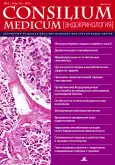Индивидуальные и госпитальные глюкометры: баланс между несомненной пользой и безопасностью
- Авторы: Моругова Т.В1, Шестакова М.В2
-
Учреждения:
- ГБОУ ВПО Башкирский государственный медицинский университет Минздрава России, Уфа
- ФГБУ Эндокринологический научный центр Минздрава России, Москва
- Выпуск: Том 16, № 4 (2014)
- Страницы: 19-22
- Раздел: Статьи
- URL: https://journals.rcsi.science/2075-1753/article/view/94005
- ID: 94005
Цитировать
Полный текст
Аннотация
Ключевые слова
Полный текст
Открыть статью на сайте журналаОб авторах
Т. В Моругова
ГБОУ ВПО Башкирский государственный медицинский университет Минздрава России, Уфа
М. В Шестакова
ФГБУ Эндокринологический научный центр Минздрава России, Москва
Список литературы
- Medicines and Healthcare Products Regulatory Agency, UK, Depatment of Health, Medical device alert. MDA/2007/058 - Point of care and home - use blood glucose meters: Roch Accu - chek and Glucotrend; Abbot Diabetes Care FreeStyle. 2007 Available from: www.mhra.gov.uk
- Blank F.S.J, Miller M, Nichols J et al. Blood glucose measurement in patients with suspected diabetic ketoacidosis: a coparison of Abbott Medisense PCx point - of care meter values to reference laboratory values. J Emerg Nurs 2009; 35 (2): 93-6.
- Bond W.W, Favero M.S, Petersen N.J et al. Survivsl of hepatitis B virus after drying and storage for one week. Lancet 1981; 1: 550-1.
- Counard C.A, Perz J.F, Linchangco P.C et al. Acute Hepatitis B outbreaks related to fingerstick blood glucose monitoring in two assisted living facilities. J Am Geriartr Soc 2010; 58 (2): 306-11.
- Flaum A, Malmros H, Preston E. Elin nosocomiale icterus - epedememie. Acta Med Scand 1926; Suppl. 1: 544-53.
- Desenenclos J.C, Bourdiol-Raze’s M, Rolin B et al. Hrpatitis C in a ward for cystic fibrosis and diabetic patients: possible transmission by spring - loaded finer - stick devices for self - monitoring of capillary blood glucose. Infect Control Hosp Epidemiol 2001; 22 (11): 707.
- Polish L.B, Shapiro C.N, Bauer F et al. Nosocomial transmission of hepatitis B virus associated with the use a spring - loaded finger - stick device. N Engl J Med 1992; 326 (11): 721-5.
- Nosocomial of hepatitis B virus infection associated with reusable fingerstick blood sampling devices - Ohio and New York city, 1996. CDC. MMWR 1997; 46 (10): 217-21.
- Polish L.B, Shapiro C.N, Bauer F et al. Nosocomial transmission of hepatitis B virus associated with a spring - loaded finger stick device. N Engl J Med 1992; 326 (11): 721-5.
- Klonoff D.C, Perz J.F. Assisted monitoring of blood glucose: special safety needs for a new paradigmin testing glucose. J Diabetes Sci Technol 2010; 4 (5): 1027-31.
- Louie R.F, Lau M.J, Lee J.H et al. Multicenter study of the prevalence of blood contamination on point - of - care glucose meters and recommendations for controlling contamination. Point Care 2005; 4 (4):158-63.
- Hellinger W.C, Grant R.L, Hernke D.A. Glucose meters and opportunities for in - hospital transmission of infection: quantitative assessment and management with and without patient assignment. Am J Infect Control 2011; 39: 752-6.
- Nichols J.H. Blood glucose testing in the hospital: error sources and risk management. J Diabetes Sci Technol 2011; 5 (1): 173-7.
- Wilkerson K, Hodge E.M. P9-081: Glucometer cleaning: a process improvement following a stste survey. Am J Infect Conrol 2011; 39 (5): E165.
- Kost G.J, Tran N.K, Louie R.F et al. Assessing the performance of handheld glucose testing for critical care. Diabetes Technol Therapeut 2008; 10 (6): 445-1.
- Centers for Disease Control and Prevention during blood glucose monitoring and insulin administration, CDC Atlanta, GA. 2010. Available from: http://www.cdc.gov/injectionsafety/blood-glucose-monitoring.html
Дополнительные файлы






